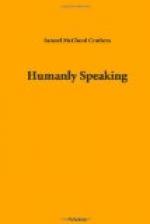To-day, the Roman Church is more conscious of its strength in Massachusetts than it is near the Vatican. At the period when the Papacy was at its height, and kings and emperors trembled before it in England and in Germany, the Popes had a precarious hold on their own city. Rome was a religious capital rather than a religious centre. It did not originate new movements. Missionaries of the faith have not gone forth from it, as they went from Ireland. It is not in Rome that we find the places where the saints received their spiritual illuminations, and fought the good fight, and gathered their disciples. Rome was the place to which they came for judgment, as Paul did when he appealed to Caesar. Here heretics were condemned, and here saints, long dead, were canonized. Neither the doctrines nor the institutions of the Catholic Church originated here. Rome was the mint, not the mine. That which received the Roman stamp passed current throughout the world.
In the political struggle for the New Italy, Rome had the same symbolic character. Mazzini was never so eloquent as when portraying the glories of the free Rome that was to be recognized, indeed, as the mother of us all. The Eternal City, he believed, was to be the regenerating influence, not only for Europe but for all the world. All the romantic enthusiasm of Garibaldi flamed forth at the sight of Rome. All other triumphs signified nothing till Rome was the acknowledged capital of Italy. Silently and steadily Cavour worked toward the same end. And at last Rome gathered to herself the glory of the heroes who were not her own children.
If we recognize the symbolic and representative character of Roman history, we can begin to understand the reason for the bewilderment which comes to the traveler who attempts to realize it in imagination. Roman history is not, like the tariff, a local issue. The most important events in that history did not occur here at all, though they were here commemorated. So it happens that every nation finds here its own, and reinforces its traditions. In the Middle Ages, the Jewish traveler, Benjamin of Tudela, found much to interest him. In Rome were to be found two brazen pillars of Solomon’s Temple, and there was a crypt where Titus hid the holy vessels taken from Jerusalem. There was also a statue of Samson and another of Absalom.
The worthy Benjamin doubtless felt the same thrill that I did when looking up at the ceiling of the Church of Santa Maria Maggiore. I was told that it was gilded with the first gold brought from America. The statement, that the church was founded on this spot because of a vision that came to Pope Liberius in the year 305 A.D., left me unmoved. It was of course a long time ago; but then, I had no mental associations with Pope Liberius, and there was no encyclopaedia at hand in which I might look him up. Besides, “the church was reerected by Sixtus III in the year 432, and was much altered in the twelfth century.” But the gold on the ceiling was a different matter. That was romantically historical. It came from America in the heroic age. I thought of the Spanish galleons that brought it over, and of Columbus and Cortes and Alvarado. After that, to go into the Church of Santa Maria Maggiore was like taking a trip to Mexico.




